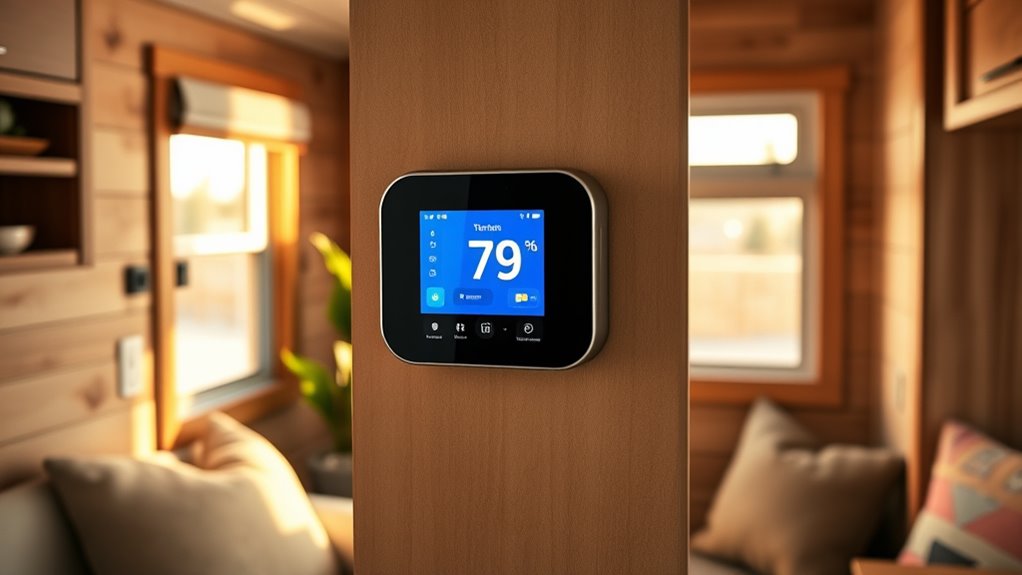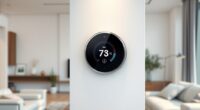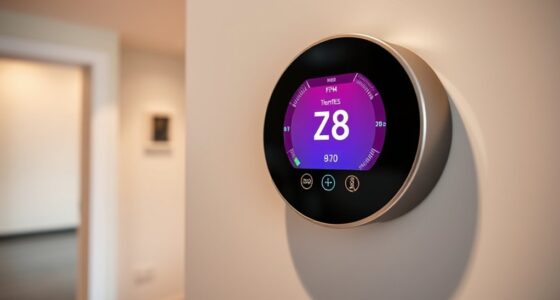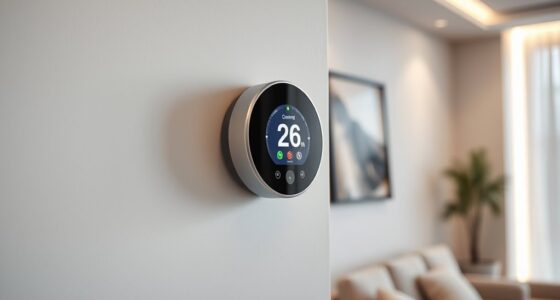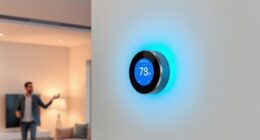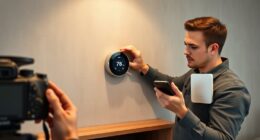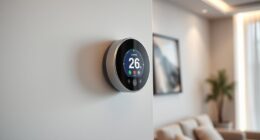If you’re looking for the best smart thermostats for your mobile home, I recommend options like the Sensi Touch 2, Honeywell Wi-Fi 9000, ecobee Smart Thermostat, and simple digital models like Honeywell RTH21B. These devices combine comfort, energy efficiency, and modern connectivity features like voice control and app management. They are easy to install and compatible with most HVAC systems. Keep exploring to find out more about which model fits your needs best.
Key Takeaways
- Compatibility with various HVAC systems in mobile homes ensures versatile installation options.
- Features like remote control, voice integration, and programmable schedules enhance comfort and convenience.
- Easy DIY installation with visual wiring guides and minimal setup simplifies upgrades in mobile homes.
- Energy-saving functions and auto-scheduling optimize efficiency and reduce utility costs.
- Robust connectivity and support for smart home ecosystems ensure reliable operation and future expandability.
Sensi Touch 2 Smart Thermostat with Touchscreen Display

If you’re looking for a smart thermostat that’s easy to install and use, the Sensi Touch 2 with its sleek touchscreen display is an excellent choice for mobile home owners. It features Wi-Fi connectivity, programmable scheduling, and voice control compatibility with Alexa, Google Assistant, and Samsung SmartThings. Designed for DIY installation, it guides you through setup with an intuitive app. Compatible with most HVAC systems, including boilers, heat pumps, and furnaces, it supports room sensors to balance temperatures and boost energy efficiency. With ENERGY STAR certification and user-friendly controls, the Sensi Touch 2 helps you stay comfortable while saving on energy costs.
Best For: mobile home owners seeking an easy-to-install, energy-efficient smart thermostat with a sleek touchscreen display and voice control compatibility.
Pros:
- Easy DIY installation guided by an intuitive app
- Supports room sensors for balanced heating and cooling
- Compatible with popular voice assistants like Alexa, Google Assistant, and Samsung SmartThings
Cons:
- Limited temperature adjustment ranges for auxiliary heat or low-temperature settings
- Some users experience difficulty accessing outside temperature data on the thermostat
- Variability in technical support response and potential hardware reliability concerns
Honeywell Wi-Fi 9000 Color Touch Screen Thermostat
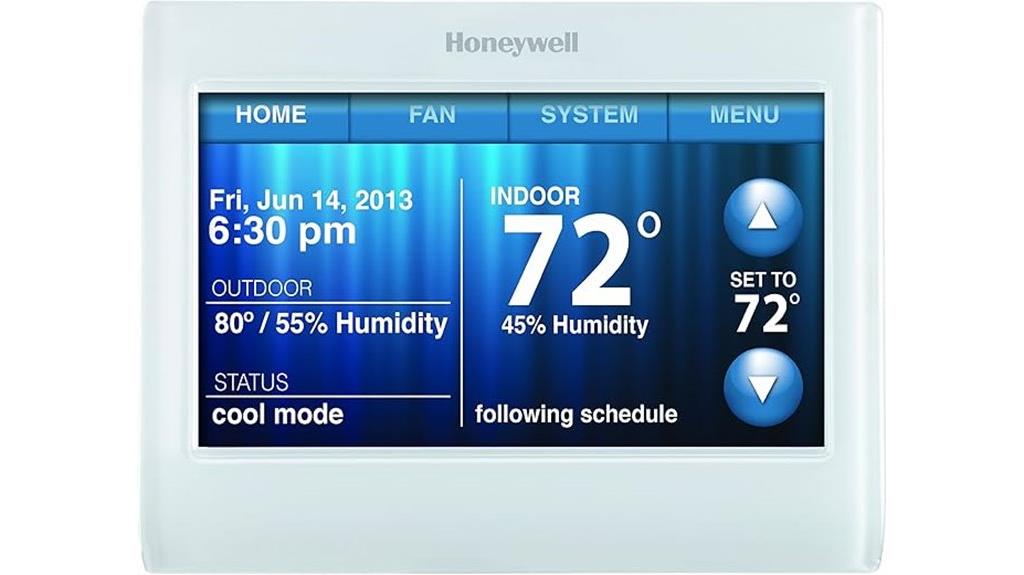
The Honeywell Wi-Fi 9000 Color Touch Screen Thermostat stands out for its sleek design and user-friendly touch interface, making it an excellent choice for homeowners seeking a modern, easily controllable HVAC solution. Its 4.5-inch LCD display offers customizable background colors, and it supports remote control via smartphone app, giving you flexibility wherever you are. Built for easy installation, it requires a C wire and is compatible with various systems, including light commercial units. With features like scheduling, voice control compatibility, and Energy Star certification, this thermostat combines convenience, style, and energy efficiency—perfect for those wanting a high-tech upgrade for their mobile home.
Best For: homeowners and small business owners seeking a modern, customizable, and remotely controllable Wi-Fi-enabled thermostat for their HVAC systems.
Pros:
- Sleek, user-friendly touch screen with customizable background colors for a personalized look
- Supports remote control via smartphone app, enabling convenient adjustments from anywhere
- Compatible with various systems and offers scheduling and voice control features for added convenience
Cons:
- Requires a C wire for installation, which may not be present in all setups
- Designed primarily for professional installation, though it can be self-installed with proper wiring
- Slightly higher cost compared to basic thermostats, reflecting its advanced features and modern design
Non-Programmable Digital Thermostat for Home
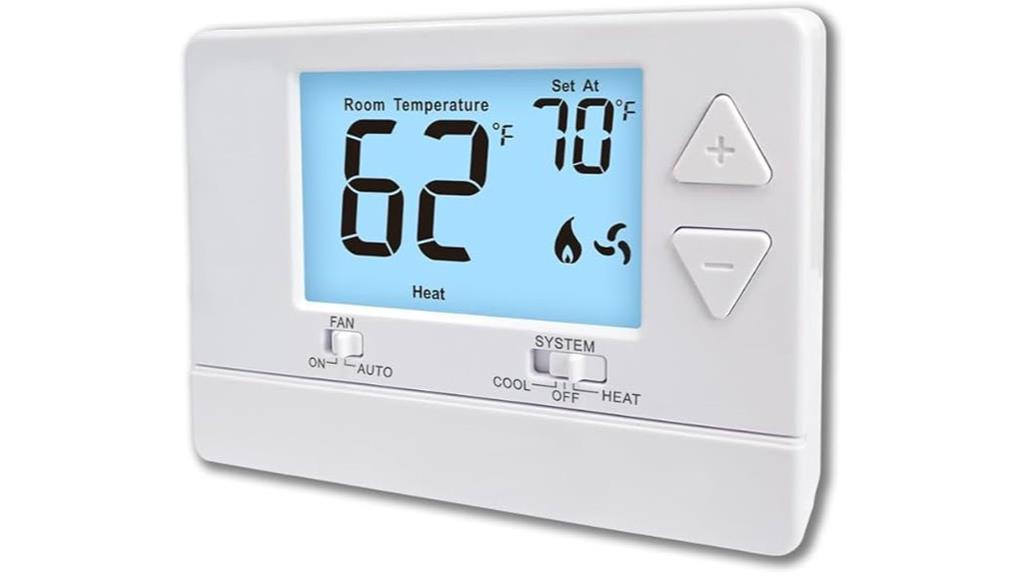
A non-programmable digital thermostat is an excellent choice for homeowners seeking a simple, reliable way to control their heating and cooling without the complexity of advanced features. It features a large backlit LCD display, easy push-button controls, and supports single-stage systems like gas or electric furnaces and boilers. Installation is straightforward, often taking less than 30 minutes, thanks to its universal sub-base and clear wiring instructions. Powered by 24VAC or 2 AA batteries, it eliminates the need for a C-wire in most cases. Its straightforward operation and reliable performance make it ideal for those who want basic, effective climate control.
Best For: homeowners seeking a simple, easy-to-install thermostat for single-stage heating and cooling systems without the need for programming or advanced features.
Pros:
- Easy DIY installation with clear wiring instructions and universal sub-base
- Large, bright backlit LCD display for easy reading and operation
- Supports dual power options (24VAC or 2 AA batteries), eliminating the need for a C-wire in most cases
Cons:
- Limited to single-stage heating and cooling systems, not suitable for multistage or heat pump setups
- Supports only 2 to 5 wires, incompatible with systems requiring more wiring connections
- Lacks advanced programming or smart features for customization or remote control
Non-Programmable Thermostat for Home Systems

Non-programmable thermostats are ideal for homeowners seeking straightforward, reliable climate control without the complexity of advanced scheduling features. They support a wide range of systems, including forced air, electric furnaces, hot water steam, and heat pumps without auxiliary heat. Installation is simple, often taking less than 30 minutes, thanks to large terminal blocks and a universal base. These thermostats feature clear backlit displays and intuitive controls, allowing easy adjustments like temperature calibration and swing settings. They operate on 24VAC power or batteries, and most don’t require a C-wire, making them versatile and user-friendly for various home heating and cooling setups.
Best For: homeowners seeking a simple, reliable thermostat compatible with various heating and cooling systems without the need for programming or complex setup.
Pros:
- Easy DIY installation typically completed in less than 30 minutes.
- Supports a wide range of system types, including forced air, electric furnaces, and heat pumps without auxiliary heat.
- Features a clear backlit display and intuitive controls for straightforward operation and adjustments.
Cons:
- Not compatible with heat pumps that have auxiliary/emergency heat or dual fuel systems.
- May require a C-wire for certain heat-only or cool-only systems, which could complicate installation.
- Lacks advanced programming features, making it unsuitable for users seeking scheduled or programmable climate control.
Sensi Lite Smart Thermostat
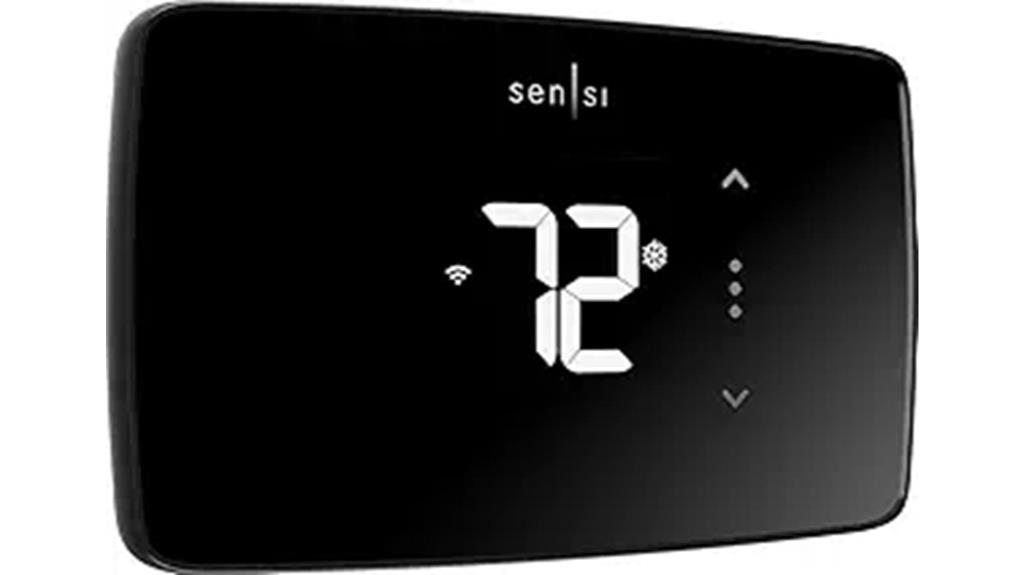
If you’re seeking a budget-friendly, easy-to-install thermostat that offers smart control without complicated wiring, the Sensi Lite Smart Thermostat by Emerson is an excellent choice. It’s Energy Star certified, compact, and features a clear LCD display with backlighting. Compatible with most HVAC systems like boilers, heat pumps, and air conditioners, it supports app control via Wi-Fi and works with Alexa, Google Assistant, and SmartThings. Setup is straightforward with step-by-step instructions, and it doesn’t require a C-wire on most systems. While some connectivity issues may occur after outages, users appreciate its affordability, simple design, and energy-saving features.
Best For: budget-conscious homeowners seeking an easy-to-install, energy-efficient smart thermostat compatible with most HVAC systems and voice assistants.
Pros:
- Simple DIY installation with clear instructions and minimal wiring requirements
- Compatible with popular voice assistants like Alexa, Google Assistant, and SmartThings
- Energy Star certified, helping users save approximately 23% on HVAC energy costs
Cons:
- Potential connectivity issues after power outages or battery changes that may require troubleshooting
- Limited scheduling flexibility and app-based data reporting features
- Not recommended for use outside US and Canada due to regional restrictions
Sensi Smart Thermostat, Wi-Fi & Alexa Compatible
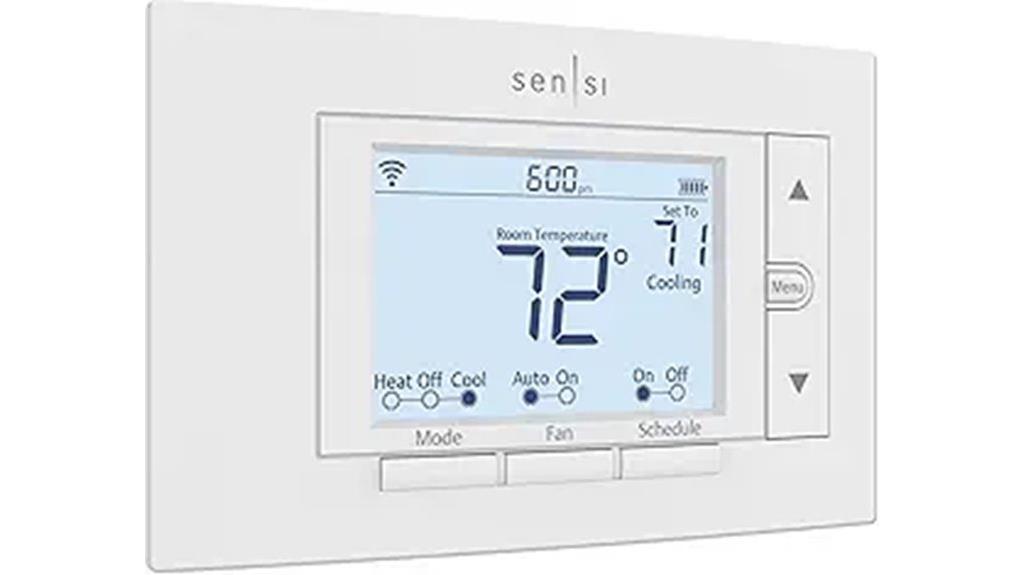
The Sensi Smart Thermostat stands out as an excellent choice for mobile home owners seeking seamless Wi-Fi connectivity and voice control compatibility. It features a sleek LED display, backlit buttons, and easy DIY installation that fits into existing spaces without patching or painting. Compatible with most HVAC systems, it often requires no c-wire, making setup straightforward. With built-in Alexa, Google Assistant, SmartThings, and Vera support, controlling your climate is simple via voice commands. Plus, its energy-saving features, such as scheduling and remote access, help reduce bills by around 23%. Reliable and privacy-focused, the Sensi thermostat offers dependable performance backed by a three-year warranty.
Best For: homeowners, particularly in mobile or modular settings, seeking easy DIY installation, Wi-Fi connectivity, and voice control for energy-efficient climate management.
Pros:
- Easy DIY installation with no patching or painting required
- Compatible with most HVAC systems and often requires no c-wire
- Energy-saving features that can reduce bills by approximately 23%
Cons:
- Limited detailed usage data and reporting features
- No support for Bixby voice commands
- Occasional connectivity or setting adjustment issues reported by some users
Ecobee Smart Thermostat Essential
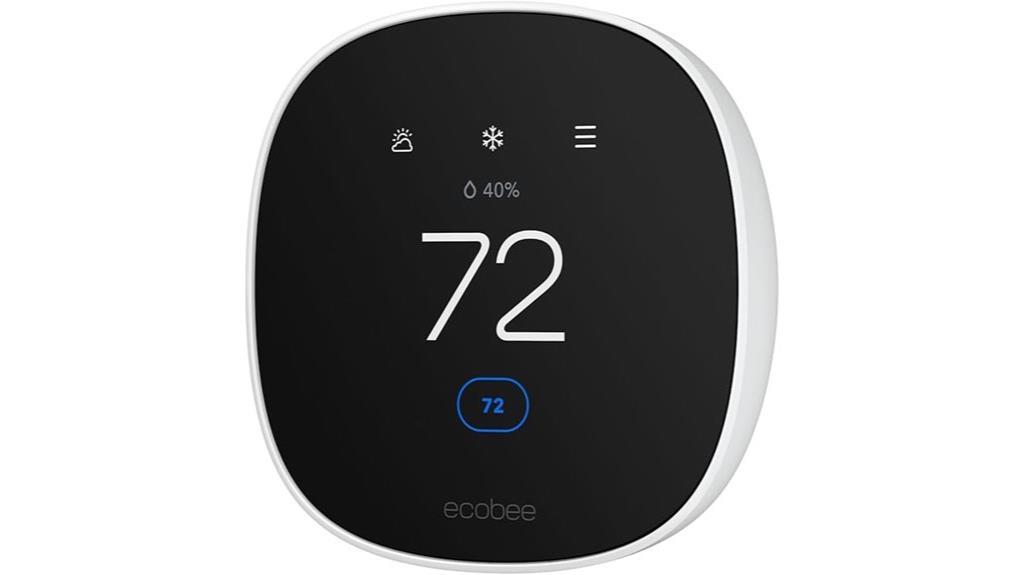
The Ecobee Smart Thermostat Essential stands out as an excellent choice for mobile home owners seeking energy savings and seamless smart home integration. It’s Energy Star certified and compatible with Siri, Alexa, Google Assistant, and Apple HomeKit, making control simple and versatile. Its intuitive LCD display and touchpad allow easy adjustments, while features like auto-scheduling and auto-away mode optimize HVAC performance. Designed for electric baseboard heaters, air conditioners, and furnaces, it can save up to 23% on energy bills—often paying for itself in just six months. Installation is straightforward, especially for DIYers, and the app provides convenient remote control and scheduling options.
Best For: homeowners seeking an easy-to-install, energy-efficient smart thermostat compatible with multiple voice assistants and home ecosystems.
Pros:
- Compatible with Siri, Alexa, Google Assistant, and Apple HomeKit for versatile smart home integration
- Easy DIY installation with straightforward setup and intuitive app controls
- Potential energy savings of up to 23%, often recouping the cost within six months
Cons:
- Limited scheduling flexibility, allowing only one schedule per season
- Cannot set different schedules for different seasons without manual re-entry
- Scheduling is restricted to 30-minute intervals, lacking minute-level customization
Amazon Smart Thermostat
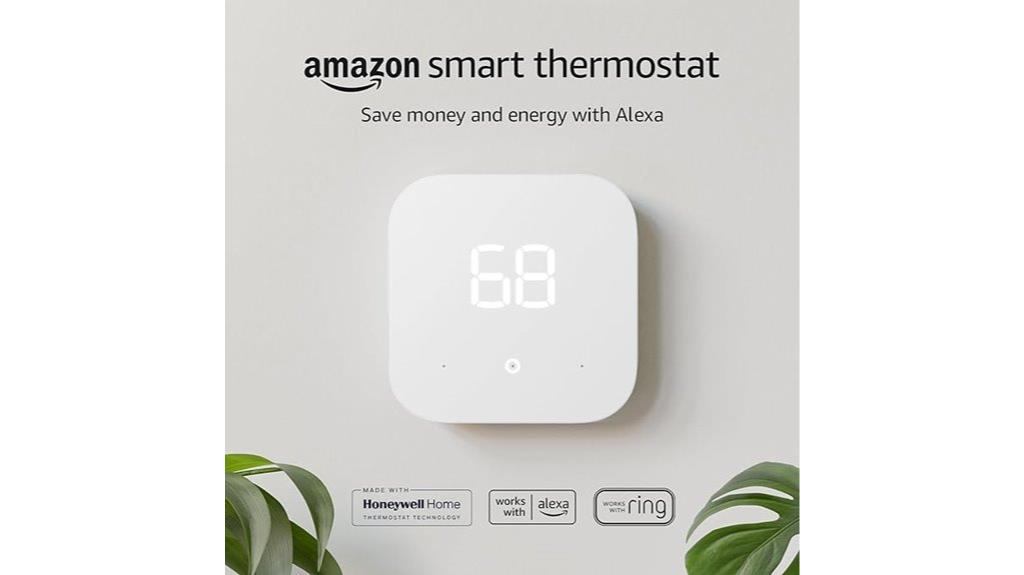
For anyone looking to upgrade their mobile home’s heating and cooling system with a smart, user-friendly option, the Amazon Smart Thermostat stands out. It easily replaces traditional thermostats and supports C-wire installation for seamless setup. With Alexa and Ring integration, you can control your climate via voice or app, making adjustments from anywhere. It helps save energy and reduce bills, with EPA estimates showing around $50 yearly savings. Guided installation and reliable support make setup simple. Built with Honeywell technology and backed by over a century of expertise, this thermostat offers durability, smart automation, and compatibility with popular Echo devices, ensuring comfort and convenience.
Best For: homeowners seeking an easy-to-install, energy-saving smart thermostat compatible with Alexa and Ring devices for remote control and automation.
Pros:
- Seamless integration with Alexa and Ring for voice and app control
- Supports C-wire installation for straightforward setup
- Helps reduce energy costs, with EPA estimates of $50 savings annually
Cons:
- Limited compatibility with non-Alexa or Ring smart home systems
- Requires a C-wire for installation, which may not be present in all homes
- Basic features may lack advanced customization options found in higher-end thermostats
Meross Smart WiFi Thermostat with Matter, Alexa & HomeKit Compatibility
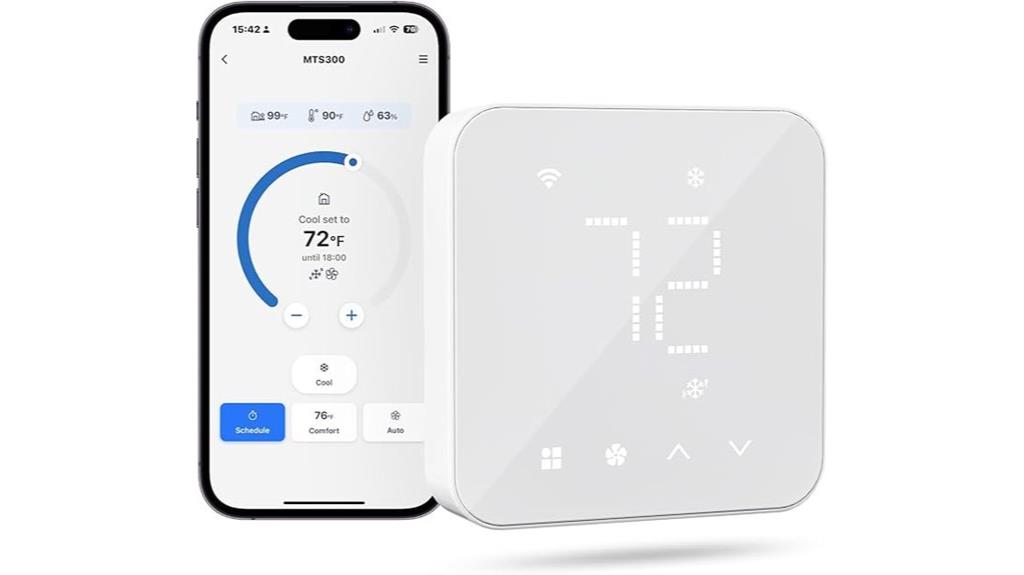
If you’re looking for a smart thermostat that integrates seamlessly with popular voice assistants and smart home platforms, the Meross Smart WiFi Thermostat with Matter, Alexa, and HomeKit compatibility is an excellent choice. It works with 95% of HVAC systems, including heat pumps and conventional setups, but needs a C-wire for proper operation. It supports customizable 7×24-hour schedules that run even without Wi-Fi, ensuring consistent comfort. You can control it remotely via the app and enjoy voice commands through Alexa, Apple Home, Google, and Samsung SmartThings. Plus, it helps save energy by tracking usage, making it both smart and efficient for your mobile home.
Best For: homeowners seeking a versatile, easy-to-integrate smart thermostat compatible with major voice assistants and smart home platforms, suitable for most HVAC systems.
Pros:
- Compatible with Matter, Alexa, Apple HomeKit, Google Home, and Samsung SmartThings for seamless platform integration
- Supports customizable 7×24-hour schedules that function without Wi-Fi, ensuring consistent comfort
- Allows remote control and monitoring via the app for convenient management from anywhere
Cons:
- Requires a C-wire for installation; incompatible with systems lacking one unless a C-wire adapter is purchased
- Not suitable for electric baseboard heaters
- Limited to 2.4GHz Wi-Fi networks, which may affect connectivity in some setups
ecobee Smart Thermostat Enhanced, Programmable Wi-Fi Thermostat
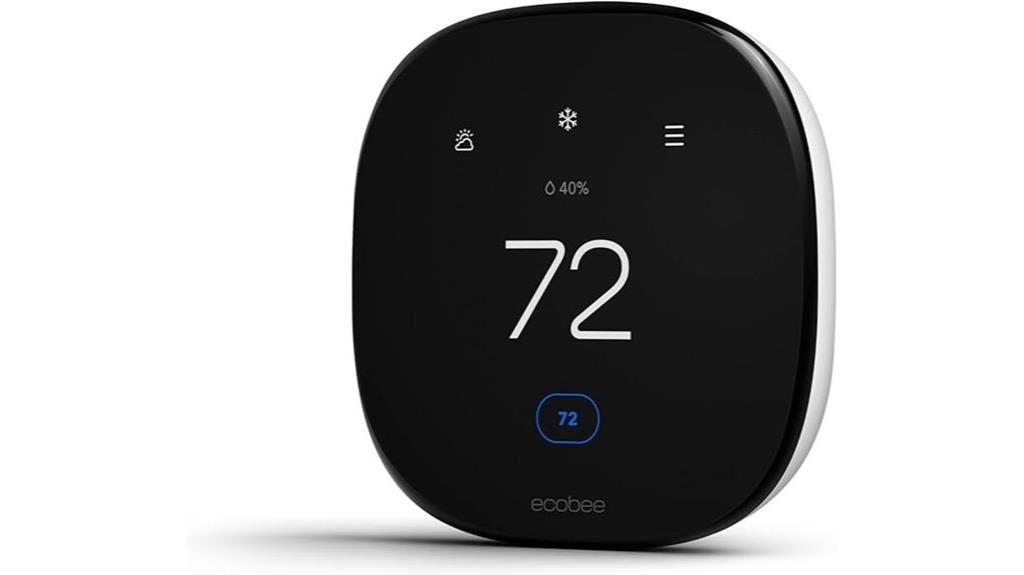
Energy-conscious homeowners seeking to reduce heating and cooling costs will find the ecobee Smart Thermostat Enhanced an excellent choice. It can save up to 26% annually by automatically adjusting temperatures when you’re away and preheating or precooling your home for comfort. The thermostat considers humidity to maintain consistent comfort levels and uses SmartSensor technology to focus on key areas. It integrates seamlessly with Siri, Alexa, Google Assistant, and most smart home platforms. Easy to install, even without a C-wire, and compatible with most HVAC systems, it’s a reliable, energy-efficient device that keeps your home comfortable and connected.
Best For: energy-conscious homeowners seeking a smart, easy-to-install thermostat that reduces energy costs while maintaining comfort.
Pros:
- Saves up to 26% annually on heating and cooling costs through automated adjustments.
- Compatible with most HVAC systems and supports smart home integrations like Siri, Alexa, and Google Assistant.
- Easy installation with a Power Extender Kit, eliminating the need for a C-wire and battery replacements.
Cons:
- Requires a Wi-Fi connection for remote control and smart features, which may be a concern in areas with unstable internet.
- Some users may find setup and configuration challenging without prior smart device experience.
- The advanced features and sensors may be more than necessary for very basic heating and cooling needs.
EconoHome Adjustable Thermostat
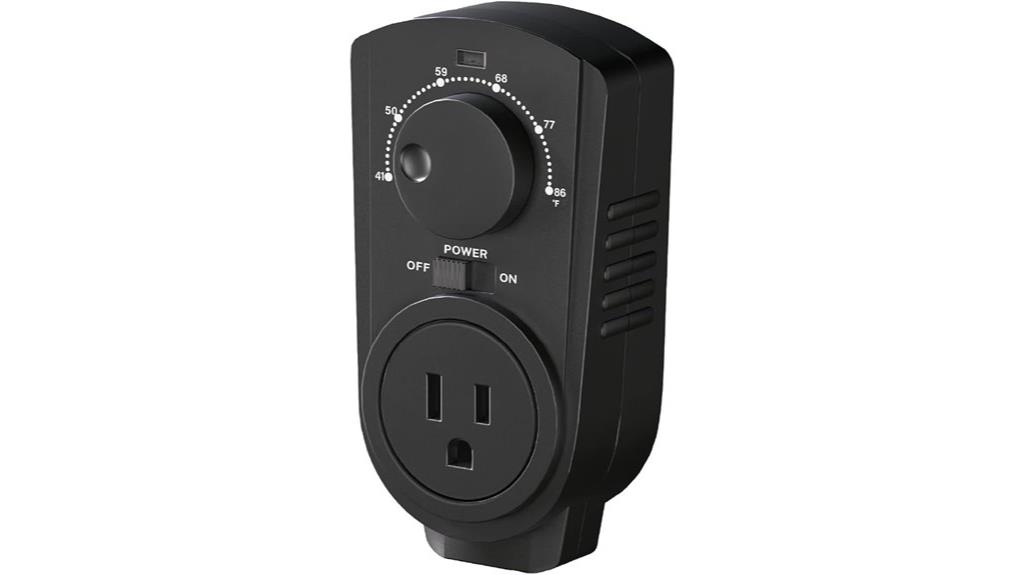
The EconoHome Adjustable Thermostat stands out as a versatile option for those seeking a simple, reliable control device for various heating and cooling applications. It’s a universal plug-in model compatible with space heaters, air coolers, fans, refrigeration units, and greenhouses. Its portable, wall-mountable design features an analog dial to set temperatures between 41-86°F. Easy to operate—just plug in, choose heat or cool, and adjust the dial—it helps maintain steady temperatures efficiently. Certified UL and ETL compliant, it offers safety features like overload protection. While some users report durability issues, many praise its affordability, straightforward functionality, and energy-saving performance.
Best For: DIY enthusiasts and homeowners seeking an affordable, easy-to-use thermostat solution for controlling heating and cooling devices in various residential or greenhouse settings.
Pros:
- Simple plug-in installation with an intuitive analog dial for easy temperature adjustments
- Compatible with a wide range of devices including space heaters, fans, and coolers
- Certified safety features like overload protection and UL/ETL compliance ensure reliable operation
Cons:
- Some users report early failure or durability issues after extended use
- Temperature set points are in Celsius for some users, requiring conversion to Fahrenheit
- Bright indicator lights may need covers to prevent disturbance during sleep or in dark environments
Sensi Lite Smart Thermostat
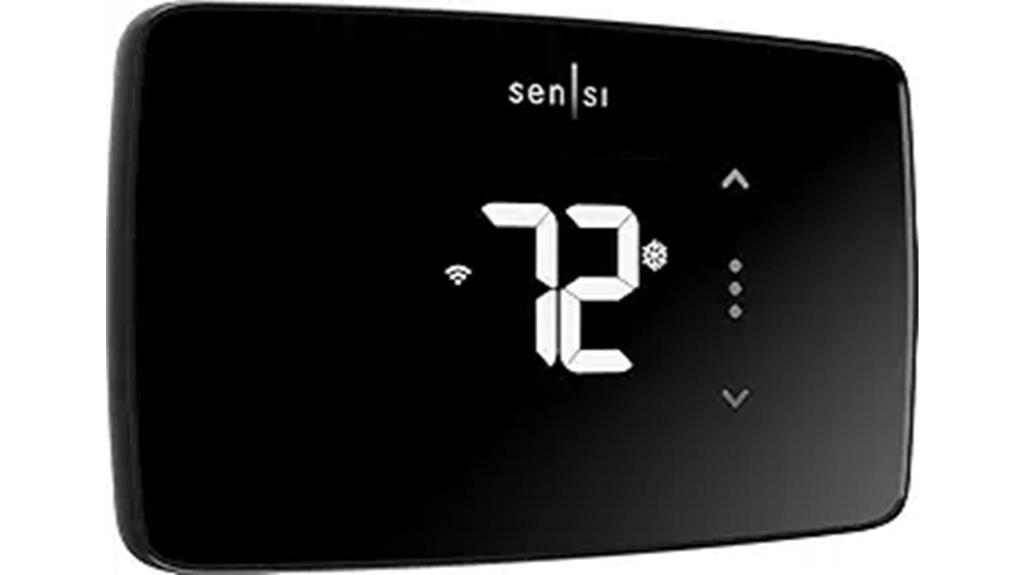
Designed for ease of use and energy savings, the Sensi Lite Smart Thermostat by Emerson stands out as an excellent choice for mobile home owners seeking a reliable, Wi-Fi-enabled control system. Its compact design, LCD display, and backlight make it simple to operate. Compatible with most HVAC systems, including boilers, heat pumps, and air conditioners, it supports app control via Wi-Fi and works with Alexa, Google Assistant, and SmartThings. Features like programmable schedules, auto changeover, and a filter indicator help optimize comfort and efficiency. Easy to install with minimal wiring, the Sensi Lite offers a user-friendly experience, making it a top option for mobile home heating and cooling control.
Best For: mobile home owners seeking an easy-to-install, Wi-Fi-enabled thermostat that offers reliable control, energy savings, and compatibility with various HVAC systems.
Pros:
- User-friendly design with LCD display and backlight for easy operation
- Compatible with most HVAC systems including boilers, heat pumps, and air conditioners
- Supports app control via Wi-Fi and integration with Alexa, Google Assistant, and SmartThings
Cons:
- Wi-Fi connectivity issues reported by some users, especially after power outages or battery changes
- Limited scheduling flexibility and app statistics, which may affect detailed energy management
- Not recommended for use outside US and Canada due to regional limitations
Honeywell Home Non-Programmable Thermostat
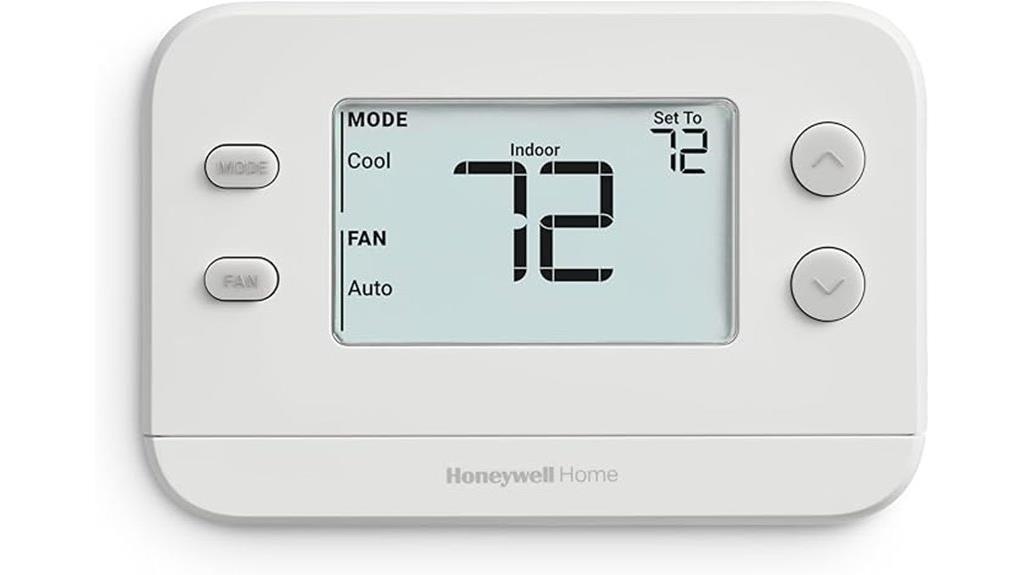
If you’re looking for a simple, reliable thermostat that’s easy to install and operate, the Honeywell Home Non-Programmable Thermostat is an excellent choice. It features a clear LCD display, push button controls, and wall-mount installation, making setup straightforward. Designed for single-stage systems, it works with gas, oil, electric forced air, and hot water heat, but not electric baseboard heat. Powered by batteries, it doesn’t need wiring, and includes a wall plate for quick upgrades. While it lacks advanced features like humidity control or smart connectivity, it’s perfect for basic temperature regulation and users seeking a no-fuss, dependable device.
Best For: homeowners seeking a straightforward, easy-to-install thermostat for basic single-stage heating and cooling systems without the need for advanced features.
Pros:
- Simple installation with included wall plate; suitable for quick upgrades
- Clear, backlit LCD display with push button controls for easy operation
- Battery-powered design eliminates the need for wiring or C-wire dependency
Cons:
- Limited to single-stage systems; not compatible with electric baseboard heat
- Lacks advanced features such as humidity monitoring or smart connectivity
- Requires frequent battery replacements as it’s not powered via wiring
Honeywell Home Programmable Thermostat, RTH21B
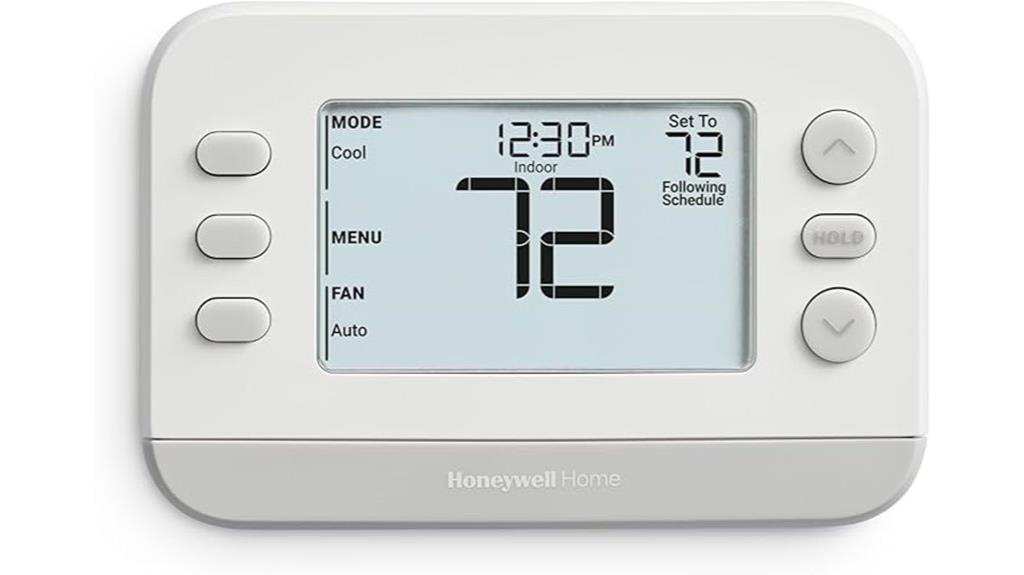
For those seeking a reliable, easy-to-install thermostat that doesn’t require a C-wire, the Honeywell Home RTH21B stands out as a smart choice. It’s designed for single-stage heating and cooling systems, making installation straightforward with its wall mount and optional decorative pieces. Powered by batteries, it uses push buttons and a backlit LCD display for easy operation. You can customize schedules for different days and times, including Wake, Home, Sleep, and Away modes. Its simple setup and dependable performance make it ideal for mobile homes, especially if you want basic programmability without the hassle of complex wiring.
Best For: homeowners seeking an affordable, easy-to-install programmable thermostat for single-stage heating and cooling systems without the need for a C-wire.
Pros:
- No C-wire required, powered by batteries for easy installation.
- Simple manual setup with straightforward operation and clear LCD display.
- Customizable scheduling options, including Wake, Home, Sleep, and Away modes.
Cons:
- Not suitable for electric baseboard heat or multi-stage systems.
- Batteries are needed and must be replaced periodically.
- Limited to single-stage systems, which may not suit more complex HVAC setups.
ecobee Smart Thermostat Premium with Sensors and Air Quality Monitor

The ecobee Smart Thermostat Premium with Sensors and Air Quality Monitor is an excellent choice for mobile homeowners seeking energy savings and enhanced comfort. It can cut heating and cooling costs by up to 26% annually and is ENERGY STAR certified for efficiency. The included SmartSensor adjusts temperatures in key rooms, reducing hot or cold spots, while the built-in air quality monitor alerts you to poor air conditions and reminds you to change filters. Its sleek design features a vibrant display and advanced interface, and it offers voice control via Siri or Alexa. Plus, it acts as a home security hub with smoke detection and optional security monitoring, making it a versatile upgrade.
Best For: homeowners seeking an energy-efficient, stylish smart thermostat with advanced air quality monitoring, voice control, and home security features.
Pros:
- Saves up to 26% annually on heating and cooling costs, with ENERGY STAR certification.
- Includes SmartSensor and air quality monitor for personalized comfort and healthier indoor air.
- Offers seamless voice control via Siri or Alexa, plus acts as a home security hub with smoke detection.
Cons:
- Requires a subscription to ecobee Smart Security plan for security features.
- Compatibility limited to most 24VAC HVAC systems; some older models may not be supported.
- Apple Home Hub needed for Siri integration, adding extra setup requirements.
Factors to Consider When Choosing a Smart Thermostat for Mobile Homes
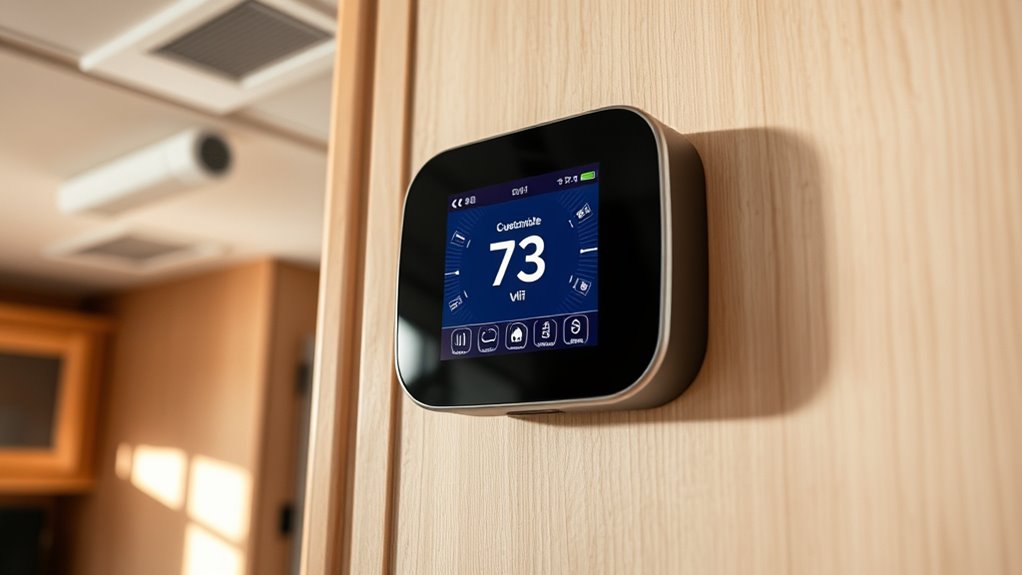
When choosing a smart thermostat for a mobile home, I consider factors like power source compatibility and how easy it is to install. I also look at remote control features and how much energy I can save with its efficiency benefits. Ultimately, understanding the temperature adjustment range helps guarantee comfort in all seasons.
Power Source Compatibility
Choosing a smart thermostat that fits your mobile home’s wiring setup is essential for smooth operation. Many models require a 24V AC power supply, common in mobile homes with standard HVAC wiring. If your system has a C-wire, you’re set—this wire supplies continuous power, ensuring reliable operation. For homes without a C-wire, battery-powered thermostats are a simple alternative, offering easy installation but needing regular battery changes. Some advanced models support power over Ethernet or use power extender kits, making them suitable for homes with limited wiring options. Always check that the thermostat’s voltage specifications match your electrical system to prevent compatibility issues. Matching the power source to your mobile home’s wiring ensures your smart thermostat functions seamlessly and reliably.
Installation Ease
Selecting a smart thermostat that is easy to install can save you time and frustration, especially in mobile homes where wiring setups vary. Look for models with clear, step-by-step instructions and compatible wiring options to make setup straightforward. Choosing thermostats that support plug-in or battery power helps avoid complex wiring, including the need for a C-wire. Additionally, prioritize units with adjustable mounting options and universal compatibility to fit different HVAC systems easily. User-friendly interfaces and minimal configuration steps also speed up installation and reduce the need for specialized tools. Visual guides and indicator lights can further clarify wiring and placement, decreasing errors during setup. Overall, an intuitive, adaptable thermostat makes installation quick, simple, and hassle-free.
Remote Control Features
Having reliable remote control features is essential for managing your smart thermostat effectively in a mobile home. A dedicated app that offers consistent remote access allows you to adjust temperatures, change schedules, and monitor energy use from anywhere with an internet connection. Voice command support through platforms like Alexa, Google Assistant, or Siri adds hands-free convenience, making it easier to control your system without lifting a finger. It’s also important that the thermostat sends notifications or alerts for system issues or maintenance needs, so you stay informed even when you’re away. Finally, confirm the device has secure Wi-Fi connectivity to prevent unauthorized access. These remote features give you peace of mind, control, and flexibility, making your mobile home climate management seamless and efficient.
Energy Efficiency Benefits
Smart thermostats not only offer convenient remote control features but also deliver significant energy savings in mobile homes. They can cut energy consumption by about 23% through scheduling, usage monitoring, and adaptive learning. These features enable precise temperature control and zoning, reducing unnecessary heating or cooling in unoccupied areas. Many models learn your habits over time, optimizing HVAC operation for maximum efficiency. Remote access allows me to adjust settings when I’m away, preventing energy waste. Additionally, integration with energy management systems and real-time usage reports help identify inefficiencies and encourage sustainable habits. Overall, a smart thermostat not only enhances comfort but also helps lower energy bills by making your mobile home’s heating and cooling more efficient.
Temperature Adjustment Range
The temperature adjustment range plays a critical role in how comfortably and efficiently your mobile home’s heating and cooling systems operate. It determines how precisely you can set your home’s temperature, directly impacting comfort and energy use. Many thermostats have a temperature swing or differential, usually between 1°F and 3°F, which influences how often the system cycles on or off. A wider adjustment range might lead to larger temperature fluctuations, potentially reducing comfort but saving energy. Some thermostats offer manual calibration of sensors to maintain accuracy within their adjustment limits. For mobile homes in extreme climates, choosing a thermostat with a broad temperature adjustment range helps accommodate seasonal variations and system capabilities, ensuring consistent comfort year-round.
Smart Home Integration
When selecting a smart thermostat for your mobile home, it is important to take into account its compatibility with your existing smart home platforms and protocols. Look for models that work seamlessly with Alexa, Google Assistant, or Apple HomeKit, so you can control your thermostat with voice commands. Supporting protocols like Zigbee, Z-Wave, or Matter guarantees your device can connect with a wide range of smart systems and sensors, boosting automation and energy savings. The ability to integrate with other smart devices, such as security cameras or motion sensors, creates a more connected home. Remote access via apps adds convenience, letting you adjust settings from anywhere. Compatibility with your current ecosystem simplifies setup and enables advanced routines based on occupancy, time, or activity, making your mobile home smarter and more efficient.
Durability in Mobile Settings
Since mobile homes are subject to more vibrations and movement, choosing a durable smart thermostat becomes essential to guarantee reliable operation. The constant shifts can loosen connections and damage delicate components, so durability is key. Exposure to extreme temperatures and humidity can also warp materials or cause malfunctions, making rugged construction vital. Look for thermostats with tough casings and corrosion-resistant parts that can withstand environmental stressors. Additionally, a compact design with secure mounting is crucial to prevent dislodging during movement. High-quality thermostats often feature reinforced wiring and sturdy internal circuitry, ensuring consistent performance despite shifting conditions. Prioritizing durability helps avoid frequent repairs and ensures your smart thermostat remains reliable, providing comfort and control in your mobile home over the long term.
Frequently Asked Questions
How Do Smart Thermostats Improve Energy Efficiency in Mobile Homes?
Smart thermostats boost energy efficiency by learning my schedule and adjusting the temperature accordingly, so I don’t waste energy when I’m not home. They allow me to set precise temperatures and control my heating and cooling remotely, ensuring I only use energy when needed. Plus, they monitor usage patterns, helping me identify ways to save more. Overall, they make my mobile home more comfortable and cost-effective to maintain.
Can Smart Thermostats Be Integrated With Solar or Alternative Energy Systems?
Imagine harnessing the sun’s power while keeping your home perfectly comfortable—that’s what integrating smart thermostats with solar or alternative energy systems can do. I’ve seen how this synergy reduces energy costs and boosts sustainability. Smart thermostats easily connect with solar setups, allowing automatic adjustments based on energy production. This integration not only saves money but also promotes eco-friendly living, making your mobile home smarter and greener every day.
Are There Specific Models Designed for Mobile Home Insulation and Ventilation Needs?
You’re asking if there are smart thermostats designed specifically for mobile home insulation and ventilation needs. I’ve found that most standard models work well, but some brands offer features tailored to mobile homes, like better humidity control and adaptable temperature sensors. I recommend looking for thermostats with flexible installation options and smart zoning, so you can optimize comfort and energy efficiency based on your mobile home’s unique insulation and ventilation setup.
How Do Smart Thermostats Handle Power Outages or Connectivity Issues?
When a power outage hits or connectivity drops, I find that many smart thermostats have backup options like batteries to keep functioning temporarily. Some models store settings locally, so I don’t lose my preferences. If Wi-Fi goes down, I can often still control the thermostat manually or through a local app. I recommend choosing a thermostat with a backup power source and offline controls for peace of mind.
What Are the Security Considerations for Wi-Fi-Enabled Thermostats?
When I think about Wi-Fi-enabled thermostats, security is key. I make sure to change default passwords and keep firmware updated regularly. I also enable two-factor authentication when possible and use a strong, unique Wi-Fi password. It’s important to keep my network protected with a robust firewall and avoid connecting the thermostat to public or unsecured networks. Staying vigilant helps prevent unauthorized access and keeps my home safe.
Conclusion
Choosing the right smart thermostat can transform your mobile home comfort. Did you know that a well-installed smart thermostat can save you up to 12% on your energy bills? That’s like getting a rebate every month just by optimizing your heating and cooling. With so many great options out there, I hope this list helps you find the perfect fit for your lifestyle. After all, a comfortable home is a smart home!
